Discover over 45 vestibular activities that can calm, regulate, and improve attention in your child. Plus, get vestibular exercises for kids that seek or avoid vestibular input.
Affiliate links used below. See our full disclosure.
Vestibular input is incredibly powerful and can have amazing or surprising effects.
Vestibular processing is nearly always at work in everything we do, arguably more than any other sensory system.
Vestibular activities, when used correctly, have the ability to calm and soothe a child, as well as improve many aspects of development like coordination, handwriting, attention, and even reading!
Unfortunately, vestibular processing is often not understood, and when we don’t understand it, we can’t use it to help our kids!
Using it incorrectly can actually make things worse! But more on that later.
Some of our kids seek vestibular input, like my son.
He loves to climb, swing high, and log roll down the hill in the backyard. But, he doesn’t stop there, and will often get creative, hanging upside down somewhere or backing himself up against a wall and climbing his feet up it with his head down so that he’s inverted!
But, some kids, and even babies, can’t stand vestibular input and avoid it like the plague, refusing to sit on a swing or maybe even disliking walking down the stairs.
And still, other children just aren’t processing vestibular input very well. In either of these cases, the effects of poor vestibular processing can have quite a ripple effect throughout their whole life.
Problems with vestibular processing can impact:
- Visual motor skills
- Body awareness
- Independence in dressing, clothing management, and daily hygeine such as hair washing
- Motor skills such as toe walking
- Posture and balance, such as W-Sitting
All of those challenges can make it difficult for our kids to learn and focus, as can sensory red flags in all of the 8 senses.
My point is that vestibular processing is a big deal!
While the vestibular system is a HUGE topic, I want to simplify it and give you just what you need to know so that you can have some real strategies for helping your sensory kiddo!
You’ll learn what vestibular input is, signs for avoiding or seeking vestibular input, amazing vestibular activities (and important safety precautions when using them), and how to help your child if they don’t like it.
What is Vestibular Input?
Vestibular input is received in the brain every single time we move our head because the receptors for this sensory system are located deep within our inner ear.
The vestibular system is made up of canals that are lined with tiny hairs and these canals also have fluid in them. When we move, the fluid swishes around in the canals and touches the hairs.
The brain gets the message about what hairs the fluid has touched and we know how and where to move! See a visual here.
That means that we get vestibular input, albeit mildly, when we turn our head or walk across the room.
The greater the movement, the more vestibular input we receive because that fluid is swishing around on the receptors more! This is why our vestibular seeking kids are always trying to up the ante.
They want bigger, more powerful vestibular input, and they’ll get it when they move fast, climb high, hand upside down, swing, or spin.
Our vestibular system is so very important because it links to our vision, auditory and proprioceptive systems, and more.
It is hard to truly localize any one part of the sensory system- they are deeply connected.
Because of that connection, vestibular processing affects eye-hand coordination (visual motor skills) and how we move our bodies (body and awareness).
If the vestibular system is under-developed or there are processing problems, you might see surprising difficulties in your child:
- Difficulty sitting still (very wiggly)
- Poor handwriting
- Poor core strength (w-sitting, hard-time sitting with good posture)
- Poor balance
- Poor motor planning (figuring out how to move the body in a new way like riding a bike for the first time)
- Difficulty problem solving
- Poor organizational skills
- Poor attention
- Clumsiness
The good news is that with vestibular activities, these challenges can be improved upon greatly! Read more about underdeveloped vestibular processing here.
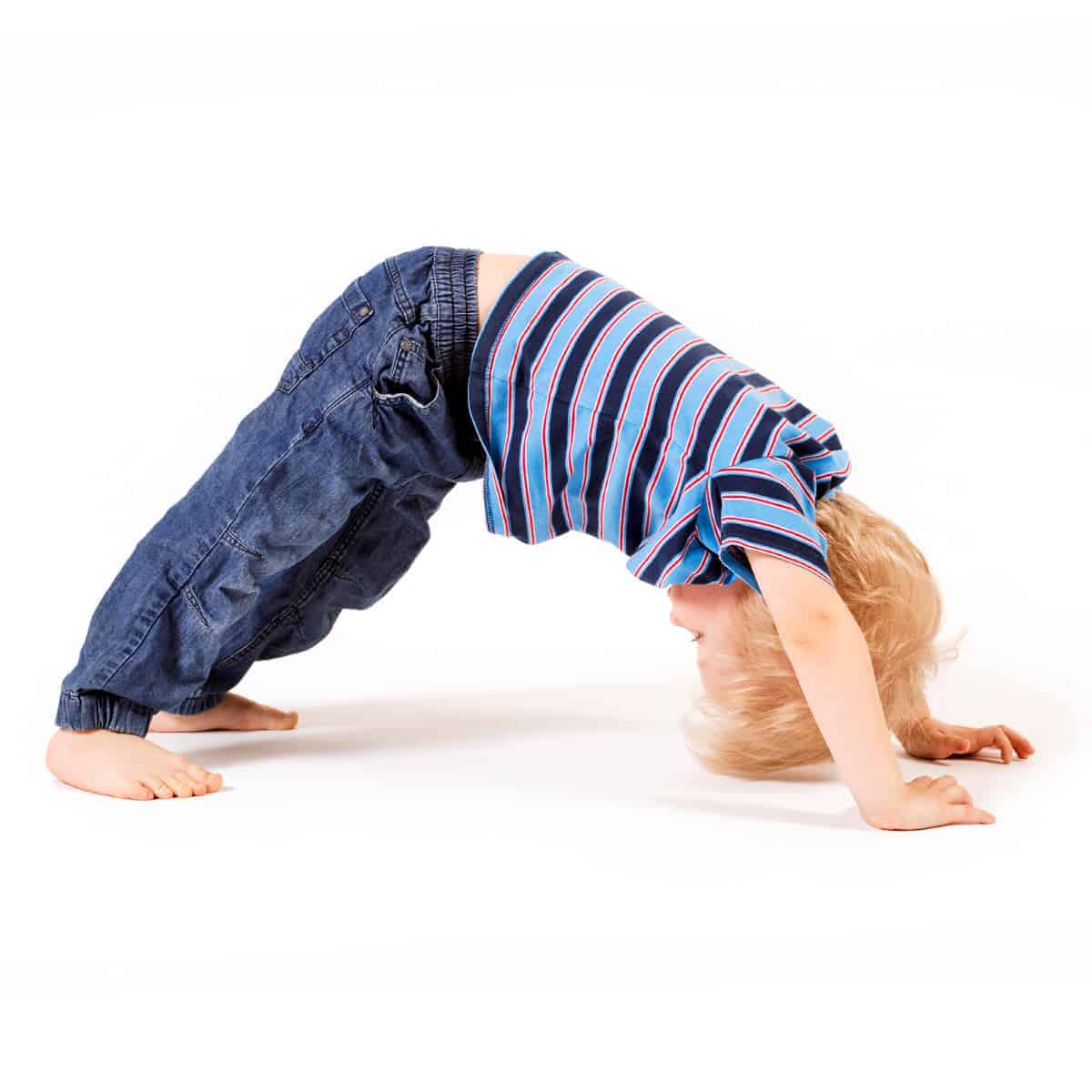
Signs for Seeking Vestibular Input
Seeking vestibular input isn’t necessarily a bad thing, some kids simply like it and enjoy the sensation.
However, if your child is constantly, almost obsessively looking for ways to get vestibular input, it can start to interfere with life.
This fixation on movement happens because their brain is underprocessing the vestibular input.
Basically, that means that the signal isn’t getting through that they’ve received vestibular input, so they keep trying to get it.
That’s where vestibular activities come in, because they can help the brain start to process the input better!
For now, let’s talk about what signs you’ll see if your child is seeking vestibular input.
Common Vestibular Seeking Behavior:
- Climbs dangerously high, can’t seem to get high enough
- Spins frequently (while standing, on swings, in swivel chairs)
- Seeks out swinging
- Never seems to get dizzy
- Always moving, running
- Enjoys being upside down, rolling, or changing directions
- Loves high speed during play
Kids that seek vestibular input also often seek proprioceptive input. These two senses are the powerhouses of the whole sensory system, and they work closely together.
Still want more ideas? Check out more in Sensory Seeking Activities!
Signs of Avoiding Vestibular Input
Avoiding, or overprocessing, vestibular input is a whole other can of worms.
Instead of the signal not getting through in the brain for seekers, kids that are sensitive to movement have too many signals being sent to the brain!
It’s on overdrive and even the little movements can seem much bigger. In more extreme cases, when kids are incredibly fearful of any type of movement, it’s called gravitational insecurity because they’re literally afraid to leave the ground in any capacity.
It’s a frightening feeling for kids when they get picked up or are moved unexpectedly.
They may feel dizzy, as if they are falling, or lose their balance. Nobody likes that, and that’s why they work hard to avoid experiencing it.
Common Vestibular Avoidance Behaviors
- Refuses to ride swings
- Won’t climb playground equipment
- Scared of movement
- Doesn’t like rough-housing
- Overwhelmed or cautious walking down stairs
- Hates being upside down, or tipping head forward or backward
- Overly cautious during play activities
- Prefers slow movement
It’s very important that we respect a child’s wishes to not participate in these activities, but helping them learn to tolerate vestibular input is equally as important.
The vestibular activities on this list will be helpful, but pay attention to the special instructions and strategies at the end!
*Get a seat in the free 3 Expert Secrets to Calm and Focus Your Kid with Sensory Activities. What you learn can change everything, you’ll get a free workbook and checklist too!*
Essential Vestibular Activities
Vestibular activities can be extremely calming and soothing, oftentimes perfect to help get kids ready for bed or winding down after school.
They can give the body a chance to recharge and relax.
At the same time, other vestibular activities may be very stimulating and arousing. This may be a good thing if your child is lethargic or has difficulty getting energized.
As always, how your child responds to these activities will be unique, and to make them successful, you’ll want to watch for that response and adjust accordingly
Pulling together what activities are helpful and when is called a sensory diet is all about.
Or, if you’re familiar, make sure you print out the sensory diet template to make organizing sensory activities even easier!
Below are over 30 vestibular activities, those that tend to be more calming are listed in the beginning. My favorite and most powerful vestibular activities are highlighted in bold:
1. Sitting in a rocking chair
2. Rocking on a yoga ball (try side to side too)
3. Rocking in a hammock
4. Swaying or slowly dancing to music
5. Yoga (especially inversion poses)
6. Sitting on a gliding chair or couch
7. Riding a rocking horse
8. Hanging upside down (from playground equipment or over a couch/bed)
9. Rocking back and forth to Row, Row, Row, Your Boat with a Partner
10. Riding a swing (this is a platform style that can be very helpful in improving vestibular processing, read more in the next section)
11. Swinging on a porch swing
12. Swinging in a blanket swing (have child lay in blanket and have two adults each hold an end and lift to swing back and forth)
13. Spinning in large circles on a tire swing (***Spinning is extremely powerful vestibular input, make sure you read the caution warning below***)
14. Spinning on a swivel chair (allow child to do themselves)
15. Riding a scooter board (one of my favorite activities because it’s portable, easy to store, and is really effective. Try while sitting and laying on belly)
16. Skipping
17. Galloping
18. Running
19. Somersaults
20. Cartwheels
21. Pull in a wagon, cart, or while on a scooter board
22. Walking across a balance beam
23. Jumping rope
24. Playing leap frog
25. Moving across monkey bars
26. Riding a see-saw
27. Wheel-barrow walking
28. Standing upside down with feet up against wall
29. Walking on a suspended bridge
30. Rough-housing
31. Sliding down slides
32. Bouncing on a large ball (we have this one)
33. Log rolling (across the floor or down a hill)
34. Jumping (try on a couch, bed, bouncy house, or trampoline for more intense input)
35. Riding a bike/scooter
36. Riding rollerblades/roller skates
37. Riding push toys/bikes/scooters down a hill
39. Playing twister
40. Sled riding
41. Singing and hand motions for “Head, Shoulders, Knees, and Toes”
42. Using a sit and spin
43. Standing or a balance board (check out this DIY version)
44. Sitting in a cone spinner or a Bilibo (both toys that encourage vestibular input)
45. Spinning (***See Below***)
46. Obstacle course that require jumping, crawling, rolling, etc.
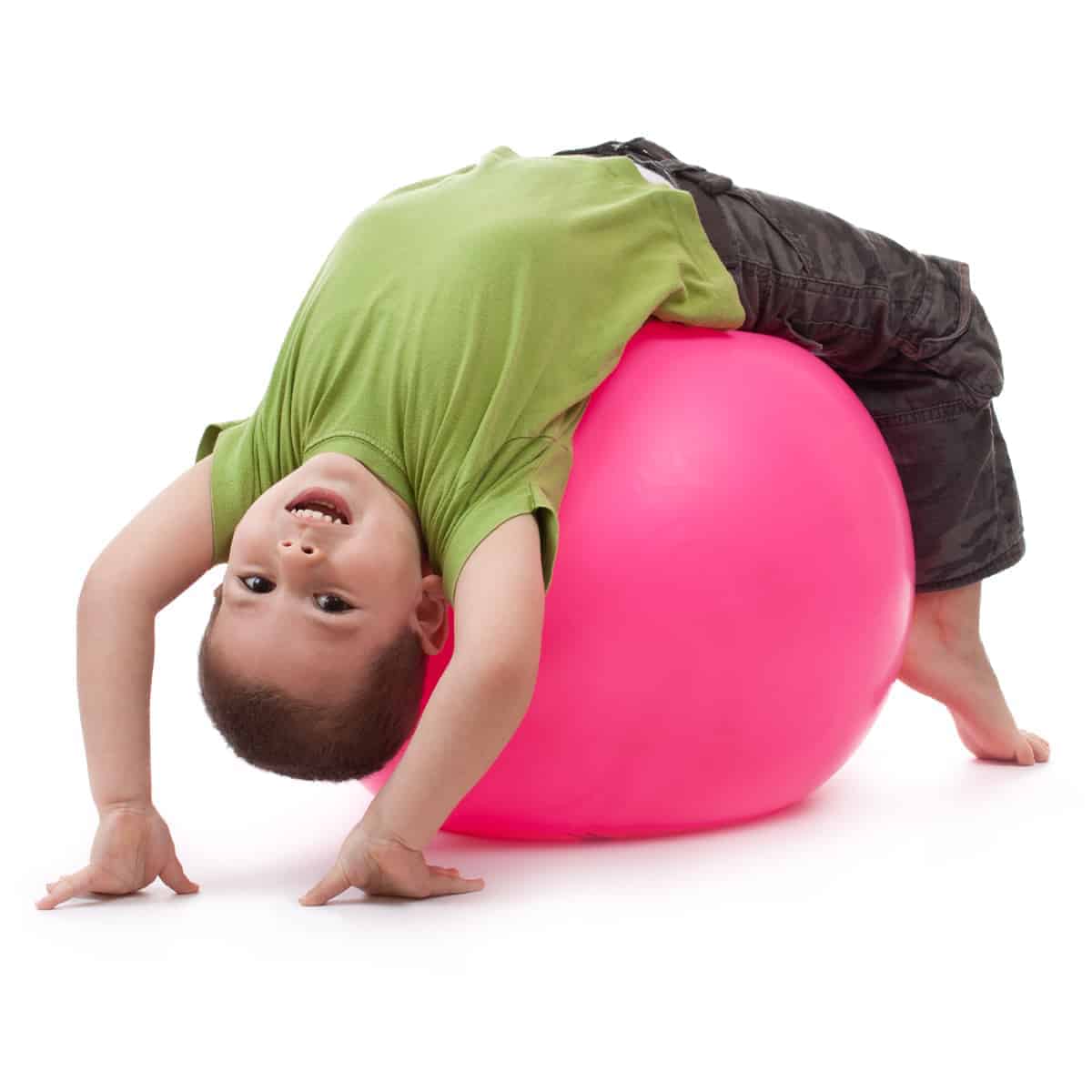
Use CAUTION with Spinning
Many vestibular input seekers LOVE spinning, and can’t seem to get enough of it. So it only seems natural to want to give it to them, right?
Well, it’s not that simple.
Spinning is the most intense sensory experience and after a short amount of time, it causes the vestibular system to literally shut off.
Or, as a response to not being able to handle the input, the brain goes into protective mode and your child will get sick. And by sick, I mean nauseous and even throwing up.
The effects of spinning can last up to 6-8 hours later, and if it was too much input, those effects might not be what you had in mind. It could be a meltdown because their sensory system is just off!
Unfortunately, I’ve seen this happen so many times.
As an OT, I have this healthy fear of spinning and am very cautious whenever I use it with kids, even kids that can’t seem to get enough.
Spinning can seem really helpful, but it’s best to go about it really methodically.
Angie Voss, occupational therapist, explains this perfectly on her blog, A Sensory Life. If you have a spinner, I highly recommend you read this!
Focus on teaching your child to spin for 10 seconds in one direction and then to stop and spin 10 seconds in the other direction. That’s it.
This is even more powerful and beneficial if you can do this on a platform swing while your child lays on their belly.
I love this platform swing because it’s by far one of the most affordable, therapy grade versions can be very pricey!
Lastly, avoid spinning your child, unless you’re following the above recommendation using a platform swing.
Allow your kiddo to spin themselves and if they’re still fixated on spinning more, redirect them to another vestibular activity. You have lots of inspiration above!
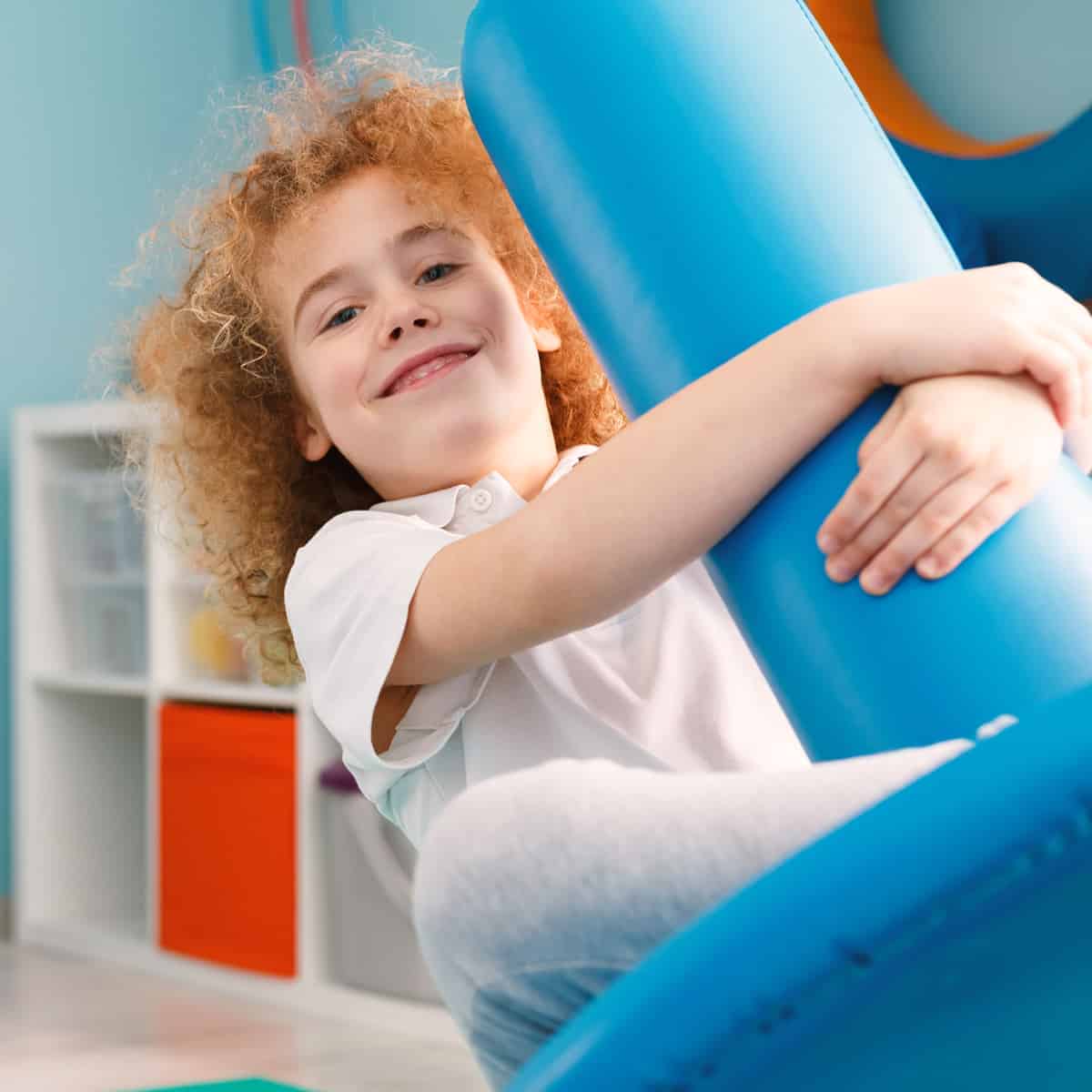
How to Help Kids Tolerate Vestibular Input and Vestibular Sensory Activities
As you read above, it’s important to help kids that avoid vestibular input to tolerate and eventually accept it through vestibular activities that will help them process it better.
However, we never want to force a child to participate in a sensory activity, especially vestibular. Here are some suggestions for helping your child accept vestibular activities:
- Start with movements that keep a child’s feet securely on the ground. Think about yoga poses and hand motions to “Head, Shoulders, Knees, and Toes” as great starting points for them to get their head inverted.
- Take small steps, allowing them to get comfortable with the activity slowly over time. For instance, you may start with just pushing a swing, then leaning against it, then sitting with one leg touching the ground, etc.
You can break down many of the vestibular activities above in similar ways. It may take weeks or months before your child readily participates.
- When using equipment that they are unsure of like a trampoline, large ball, or scooter board, keep a very firm hand or two on their shoulders, waist, or arm.
This deep pressure that you give them will be very grounding and help them feel more secure.
- Let your child know that you are there to help them, and they can let you know if they are feeling scared or dizzy.
Need Help with Vestibular Activities?
It can be hard to figure out what activities to use when with your child if you know or suspect they have sensory needs!
Some kids with vestibular processing difficulties need help from an occupational therapist. If you aren’t sure where to get started or exactly what occupational therapy for sensory needs looks like then head to: sensory integration therapy.
But, you can also get started today with helping meet your child’s sensory needs. We have an incredible freebie that’s packed with sensory activities and a sensory diet template. Get the Sensory Essentials printable pack for free here!
More Sensory Activities
Everything Oral Sensory: The Total Guide
How to Create a Quick and Easy Sensory Tent
13 Easy Sensory Strategies for the Classroom
100+ Awesome and Easy Sensory Diet Activities
Did you pin it?
Alisha Grogan is a licensed occupational therapist and founder of Your Kid’s Table. She has over 18 years experience with expertise in sensory processing and feeding development in babies, toddlers, and children. Alisha also has 3 boys of her own at home. Learn more about her here.
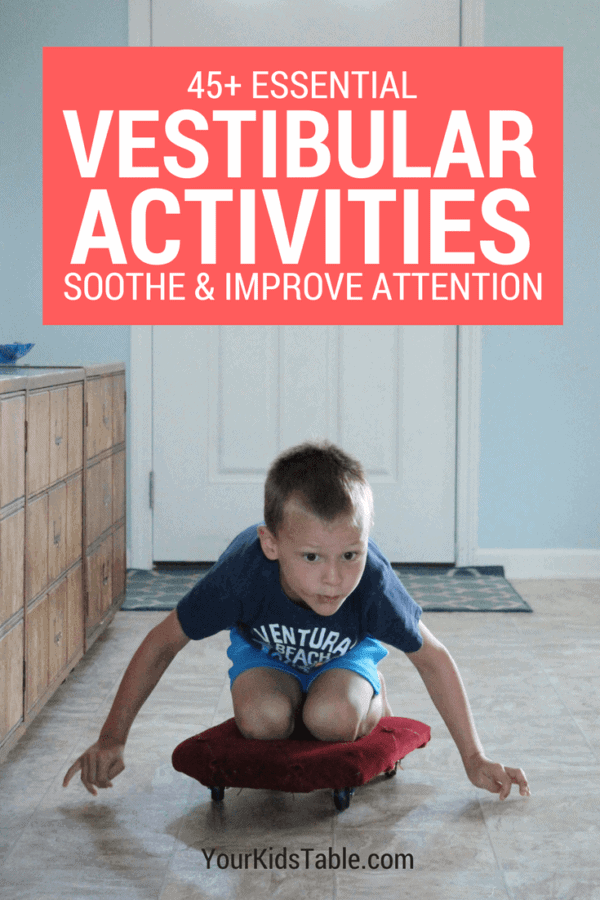
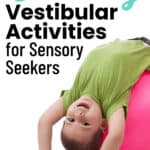
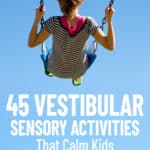
Can you make a pdf of this to give to parents? It’s such good information but so many pages to print and not everyone looks at links. Thanks!
Hi Kari! Thanks for reaching out and thanks for the feedback/suggestion! We do have another type of pdf available with vestibular activities— you can sign up for the free pdf to be sent to your email, here!
Best,
Kalyn
My child’s OT forces them to do vestibular activities like swinging/spinning but my child has come to dread OT as they are an avoider. What are some tips on how we can get my child more comfortable with this?
Hi there! Thanks for reaching out! it’s important to help kids that avoid vestibular input to tolerate and eventually accept it through vestibular activities that will help them process it better. However, we never want to force a child to participate in a sensory activity, especially vestibular. Here are some suggestions for helping your child accept vestibular activities: Start with movements that keep a child’s feet securely on the ground. Think about yoga poses and hand motions to “Head, Shoulders, Knees, and Toes” as great starting points for them to get their head inverted.
Take small steps, allowing them to get comfortable with the activity slowly over time. For instance, you may start with just pushing a swing, then leaning against it, then sitting with one leg touching the ground, etc. You can break down many of the vestibular activities above in similar ways. It may take weeks or months before your child readily participates. When using equipment that they are unsure of like a trampoline, large ball, or scooter board, keep a very firm hand or two on their shoulders, waist, or arm. This deep pressure that you give them will be very grounding and help them feel more secure. Let your child know that you are there to help them, and they can let you know if they are feeling scared or dizzy. Hope that helps!
Best,
Kalyn
I would suggest switching OT’s. A therapist should never force a child to do any activity. I’ve never met a kid who doesn’t like OT! If you find the right therapist your child will think they are playing the whole session and not “working”.
I have a 2 year old Vestibular seeker who could climb, swing, and spin on the play ground all day long. But we can do that all day, everyday. How do you get seekers to be comfortable at times when gross motor activities aren’t allowed?
Hi there! Thanks for reaching out! Try a calming sensory exercise in times like this, when gross motor activities aren’t an option. Here are 2 blog posts that can help with this: this one for joint compressions, and this one for active kids. Hope that helps!
Best,
Kalyn
Hi, thanks for a great place to find help and answers.
Our 8year old son was diagnosed with ADHD when he was 5, and even though he gets good marks in school, he struggles to get started, and even though he seems like a perfectionist, arranging everything in straight lines, he is very disorganized in school. How can we help him with exercise rather than medication please?
My 10 year old daughter likes to spin counter clockwise for 5-10 minutes a day. Twice a day – especially in the morning…Soothing. She likes and needs it. She does not over do it and has control. But she needs to spin. She gets upset at the idea there’s it’s a problem. I tend to agree . Spinning the opposite way makes no sense to her and “ruins” her sensory experience. She is a little bit on the Sprctrum
Hi Martina,
Thanks for reaching out! Often time the sensory system can play a role when kids have the wiggles and get disorganized. You might encourages some organizing activities with your son like pushing a heavy laundry basket before the school day starts. Our free sensory workshop is back open again. It might give you some great ideas! Save your seat HERE. Hope that helps!
Best,
Andrea
Maybe he is dyslexic to a degree? I agree totally with exercise. I have success taking my children for a hike – parks with trails and trail signs (to teach boundaries etc). It’s good for the parent as well! Nature! Fun!
Hi,
I have been following your site for the past 4 years. Every time my kid stims, I follow up with your recommendations.
This time, I’m stumped with my sons sensory seeking. I need some recommendations please. My kid can’t stay still and peers from the corner of his eyes.
Hi visual stimming usually go away post exercises after a few days but this time it’s not.
Hey Sue,
Thanks for reaching out! I’m glad that the activities have worked in the past. I would try changing up the activities that you are doing and adding more activities. They can change for a child, so it may be helpful for changing up the activities!
Best,
Desiree
My son has been getting a head down position very frequently he also crawls on the floor with his head rubbing against the carpet as if hes looking for input but it is very often. What could I do to help him as I am concerned he will hurt his neck?
Hey Nancy,
so glad you are reaching out and learning how to help your son. In that head down position it can be vestibular input driven. I’d try providing him with a couple of activities from the post and see what his response is. It may be a little trial and error to find a activity that works, but providing him with that input can help decrease and/or replace what he is doing now!
Best,
Desiree
Hello, my daughter had torticollis as a baby and also had vestibular issues. She did not roll over until she was 9 months old and when she did she typically only rolled to one side. She is now 2 years old and doing great. We stopped physical therapy when she started walking at 18 months. My daughters current issue is that she does not like to have her head tipped back in the bathtub to wash and rinse her hair. I read in one of your articles that this could be related to vestibular processing. With her history, I am sure this is the issue. What can I do to help develop this area and make it less traumatic for her in the tub?
Hey Christine,
Thanks for reaching out! Yes, this can definitely be a vestibular difficulty. I’d look at working with her outside the bath tub getting her head into the same tilted back position (slowly if she’s not receptive). You can do games on a therapy ball with her laying on her back and you slowly moving the ball away from you so that she is upside down. Also just in sitting play games with her above her head working on getting that head tilted back.
Hope that helps!
Best,
Desiree
This was such an interesting article. Both of my children have pretty bad motion sickness, (Along with myself) & I’m wondering if it’s related to the vestibular issues discussed. They all love & are not fearful of tire swings, platform swings etc, but literally vomit a few minutes later after a round on it. And vomit on many other things (car rides, sometimes normal swings, etc) they are both extremely active in other activities fine (gymnastics, sports, etc) Are there any daily exercises they can do to alleviate these dizziness, nausea issues with activities?
Proprioceptive activities override the vestibular system. Meaning if you follow with some prop activities (jumping, push-ups, giving deep pressure with a pillow or a ball) it can alleviate the dizziness, nausea. Also chewing gum or drinking threw a straw.
Great article! I am an OT but fairly new to pediatrics and looking for some ideas for a kiddo hypersensitive to vestibular input. He does not like any movement activities, and typically avoids movement, but then Mom says he tends to “run around” the house once a day with sometimes flapping movements. Can’t quite figure out why he is running around doing this behavior. Maybe he is regulated and feeling good at that time? Or maybe he is overstimulated?
Hey Danielle,
Thanks for reaching out and so happy you are finding some great information here to share with your patients. I’d slowly work on the vestibular and ease him into any of the activities over time. As far as the running around, I’d see what his day looks like and if it is the same time of day. Is he getting any other sensory input as far as movement throughout the day? After looking at his schedule you can try to see if it is needing input or overstimulated with activities that are happening prior.
Hope that helps!
Best,
Desiree
Love this article. Would love to talk to you and quote you in an article I am writing for teachers.
I use movement in my classroom and have for 20 years!
Thank you in advance for getting back to me.
Andrea
What are some vestibular activities for non mobile kids?
Thanks for reaching out! I would use the activities listed in the article, but have your child sit with you while completing them ie: swinging on a swing, sliding down the slide, dancing in your arms (if small enough), bouncing on a ball, etc. Your child will still be getting the inputs through the same movements.
Hope this helps!
I am an OT and am printing this off for a parent who asked me about home supports for their vestibular seeking child. I recommended your blog for more home suggestions as I don’t always feel comfortable home recommendations as I am not there to train and make adjustments.
Thanks JT and yes, I totally get it. I’m very cautious with vestibular and there’s a lot I don’t share here because certain activities require supervision!
Wow! It is so great to have tactical and precise advice for my seeker. His school thinks he can “power through” his difficulties, and I’m on the never-ending wait list here in the UK for an initial assessment. So I’m taking matters into my own hands. Everyone thinks I’m bonkers–sensory issues are not understood at all, it seems. With your tips and advice, I feel like there’s light at the end of the tunnel as I DIY a sensory diet and create a sensory den and bedroom for my son. I am so very grateful for all the information available here.
You’re not alone! We have so much work to do with educating others about sensory. You’re doing great and certainly not bonkers. Bravo for recognizing these signs in your child! Did you see the free sensory diet workshop? It would be really helpful for you!
This was and still is me 3859% !!!
…however, l am an adult.
I guess you don’t offer advise or products to adults. I’m almost 50 and it seems like there are NO Products and VERY little / limited help for adults with these issues.
And REMEMBER parents, ALL of these kids grow up into adults and autism does not vanish at age 18 but that person STILL does and most likely will not magically grow out of these issues.
I never did. I still NEED music and movement thearpy!!
I def can’t say roller coasters, zumba, and dancing relaxes me (like sleeping or a massage) but it definitely soothes and distresses me just like she said. And perhaps rocking back and forth not only helps me focus, not get distracted, and be in the now, but helps many others as well. Observing various cultures and ppl when they pray or recite something, they rock back and forth as well.
.
Thanks for sharing your experience! I think yoga can be a great vestibular activity for adults!! Especially inversion poses.
Thanks for your quick reply. I’ve done yoga many times throughout life, but I guess because I always was a hefty gal with poor balance and WAY LESS upper body strength, I NEVER got any benefit – let alone any for of relaxation – from yoga.
My mind;s way too active to settle and become clear from silence and those poses were very uncomfortable to say the least.
Roller coasters, the human gyroscope, and rides that simulate 0-gravity are the MOST IDEAL!
This along with dancing, swinging, spinning, rocking back and forth, and karaoke and jam sessions (ie, music therapy) are the ONLY times l successfully clear my mind (ie, being in the now), distress and decompression, zone out, and relax. It’s hard to think of your problems when you’re about to drop down a steep hill on a roller coaster, freely moving and dancing to your fav music blasting so loud that you CAN’T think, or singing your fav song!!
These techniques, (music and movement therapy) are effective for EVERYONE as long as you enjoy the music and moves you’re participating in.
Unlike meditation, hypno-therapy, or yoga (where you need excellent balance and powerful upper body strength….at minimum able to hold a push up (ie, downward facing dog which is yoga 001). These NEVER work for me.
That’s kind of why I STILL want an adult version of sit-and-spin. It;s an excellent triceps and arm workout and loads of fun. That and this sliding/gliding oblique exercise which as you swinging sideways as you tone your oblique.
I also LOVE sitting in a swinging chair and swinging bed. I didn’t get me dizzy, it was similar to falling asleep on the bus or train. Or how kids instantly fall asleep when you’re driving.
Perhaps Aspies are not weird, perhaps we just somehow kept in touch with those basic core human functions that NT (neuor typical) somehow grow out of once puberty and adolescence hit.
Perhaps it’s NOT that NT’s grew out of them but perhaps were so interested and ABLE to successfully fit in and mesh with everyone else, that meshing with your peers killed off those basic human desires that Aspies, Autistic ppl, ppl with Downs syndrome, etc. were not able to do. Thus we kept those human traits
Wow, can YOU read my reply?!? The format looks horrible from my end. So just in case every subsequent reply looks hard to read to you, here is my reply …..
Thanks for your quick reply. I’ve done yoga many times throughout life, but I guess because I always was a hefty gal with poor balance and WAY LESS upper body strength, I NEVER got any benefit – let alone any for of relaxation – from yoga.
My mind;s way too active to settle and become clear from silence and those poses were very uncomfortable to say the least.
Roller coasters, the human gyroscope, and rides that simulate 0-gravity are the MOST IDEAL!
This along with dancing, swinging, spinning, rocking back and forth, and karaoke and jam sessions (ie, music therapy) are the ONLY times l successfully clear my mind (ie, being in the now), distress and decompression, zone out, and relax. It’s hard to think of your problems when you’re about to drop down a steep hill on a roller coaster, freely moving and dancing to your fav music blasting so loud that you CAN’T think, or singing your fav song!!
These techniques, (music and movement therapy) are effective for EVERYONE as long as you enjoy the music and moves you’re participating in.
Unlike meditation, hypno-therapy, or yoga (where you need excellent balance and powerful upper body strength….at minimum able to hold a push up (ie, downward facing dog which is yoga 001). These NEVER work for me.
That’s kind of why I STILL want an adult version of sit-and-spin. It;s an excellent triceps and arm workout and loads of fun. That and this sliding/gliding oblique exercise which as you swinging sideways as you tone your oblique.
I also LOVE sitting in a swinging chair and swinging bed. I didn’t get me dizzy, it was similar to falling asleep on the bus or train. Or how kids instantly fall asleep when you’re driving.
Perhaps Aspies are not weird, perhaps we just somehow kept in touch with those basic core human functions that NT (neuor typical) somehow grow out of once puberty and adolescence hit.
Perhaps it’s NOT that NT’s grew out of them but perhaps were so interested and ABLE to successfully fit in and mesh with everyone else, that meshing with your peers killed off those basic human desires that Aspies, Autistic ppl, ppl with Downs syndrome, etc. were not able to do. Thus we kept those human traits
Thank you for this! I’ve been trying to put words to what we’re experiencing with my son so that SOMEONE could give me tips on how to help. Here they are! Everything on the “underwhelmed” list applies. Thanks again!
You’re so welcome! I’m so glad that it was helpful!
I am an OT student …and my doctor asked me to do a presentation about vestibular processing disorder ..can you just help me to differentiate between calming and stimulating activities
wish you could help
Hi Dalal, this should be in your course texts, but I’ll say that this can differ from person to person. OF course generally speaking fast movements are stimulating (think high on a swing) while slow rocking (like in a hammock) is calming.
Do you have any suggestions for help in a classroom. My son is a sensory seeker and is disruptive to his teacher. Thank you!
I do! Check out Sensory Strategies for the Classroom🙂
I’ve just read a few of your posts and finally feel like I have something useful to tell the doctor about my 6yo. It’s been bothering me since she was a toddler. She’s an avoider and now I realise her little sister is a seeker. Thank you!
I love hearing that Abie! That’s so wonderful, thank you for taking a minute to share that!
Is there a way to be able to get a print out of your post on what is sensory? I work at a preschool and it would be nice to have for reference and for us to read and discuss.